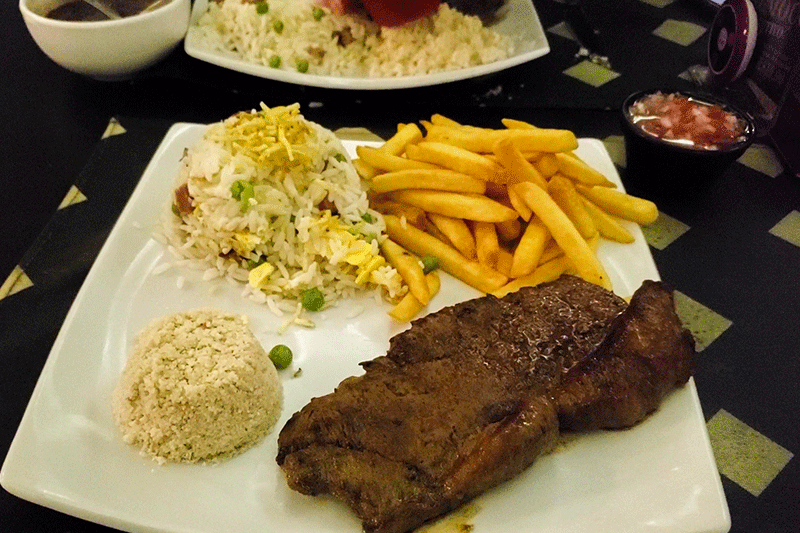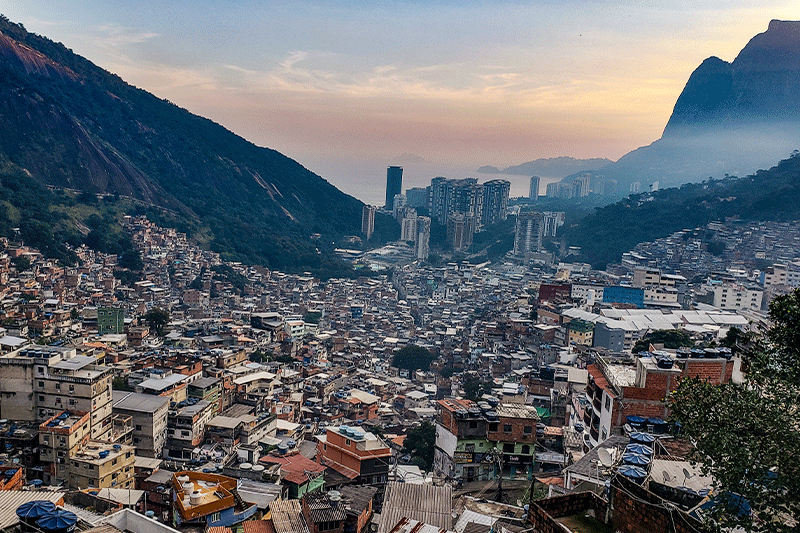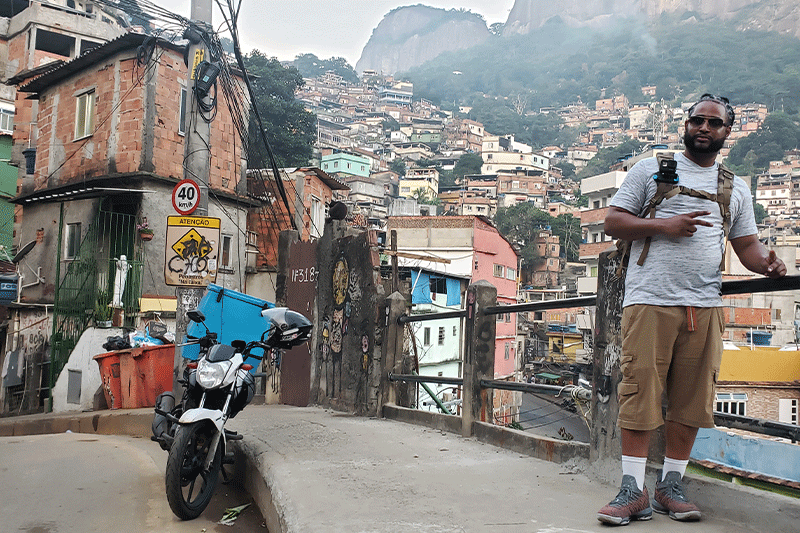The Best Favela Tour In Rio De Janeiro: Rocinha is Brazil’s Largest Favela
As a risky explorer, I’ve been fortunate to immerse myself in the rich tapestry of cultures around the world. Among these diverse experiences, one that stands out is my journey into the heart of Rio De Janeiro, Brazil – the lively and bustling Rocinha favela, known as the largest favela in Brazil. In the video below I think I captured the best favela tour in Rio De Janeiro.
The First Step into Rocinha The Largest Favela In Brazil
Stepping into Rocinha, the largest favela in Rio de Janeiro, was like entering a different world. As you traverse the narrow, winding streets of this bustling neighborhood, you’re instantly drawn in by the vibrant energy that fills the air. The favela, home to an estimated 150,000 to 200,000 residents, is a thriving urban landscape that sprawls across the hillsides, its colorful array of buildings stacked haphazardly yet harmoniously, demonstrating the community’s resourcefulness and resilience.
The sights and sounds of Rocinha are as diverse and dynamic as its residents. As you journey through the favela, your ears are filled with a symphony of sounds that encapsulate the spirit of this vibrant community – the rhythmic beats of Brazilian music echoing from local bars, the lively chatter of street vendors, the distant laughter of children playing in the streets. Out of nowhere, I could hear Busta Rhymes playing as I walked through the crowded and narrow street.
A friend Of mine Named Obie who was giving me a guided tour of Rocinha ended up taking me by his guest house that his mom built. I took a minute to soak in everything, asking him numerous questions and listening as he told me his story. We ended up going out on his roof top which I was not expecting and that is where I saw one of the best views that I’ve ever seen in my life.
The visual horizon of Rocinha is just as compelling. The favela is split into 27 different barrios, each with its unique character and charm. From the vivid graffiti murals that adorn the walls, narrating tales of local culture and history, to the bustling markets overflowing with fresh produce and handmade crafts, every sight paints a detailed picture of daily life in Rocinha. The view from the top of Obies House is particularly breathtaking, offering a panoramic view of the sprawling favela framed against the backdrop of Rio’s iconic skyline.
After talking for a while on the rooftop our next step was to visit a government housing project that was inside. Before we could even make it off his front porch, I earned one of the most memorable visions I had from the trip. I took one step forward on the stairs walking down and propelled into the air with my cigar in one hand and beer in the other. It felt like I was In the air for no less than 10 seconds as I came spiraling down.
There I was laying on my back, now empty-handed as my beer flew down a 14ft drop and my cigar was gone. I heard Obie in the background saying the word “oww” like someone just got hit lol. I quickly regained my compulsion and got up like I was ok. I was fine, my back and arm was bruised and I was a little sore but I wouldn’t trade that experience for anything lol. I was able to capture it on video. I tell everyone I almost died in the favelas nearly falling off a cliff. It’s a great travel story lol.
A Dive Into The History Of The Favelas
The history of the favelas in Brazil dates back to the late 19th century, following the abolition of slavery in 1888. With no place to live and no jobs available, many former slaves found themselves forced to settle on the outskirts of cities, where they began constructing makeshift homes from whatever materials they could find. These informal settlements soon became known as favelas, a term derived from a type of resilient plant that grew on the hillside where the first favela was established in Rio de Janeiro.
Over the years, these favelas continued to grow, fueled by waves of internal migration as people from rural areas moved to the cities in search of better opportunities. The lack of affordable housing in urban centers meant that these newcomers had little choice but to join the existing favelas. This rapid and unchecked expansion often led to overcrowded conditions, with many favelas lacking basic infrastructure and services.
Rocinha’s story mirrors this broader history, but it also stands out due to its size and location. The favela began as a small settlement in the 1920s, built by migrants from the northeast of Brazil who were attracted by job opportunities in Rio de Janeiro. Situated on a steep hillside overlooking some of the city’s wealthiest neighborhoods, Rocinha’s population began to swell in the mid-20th century as urbanization intensified.
In the decades that followed, Rocinha grew both in terms of physical size and population. Despite the challenging terrain and lack of formal planning, residents managed to build multi-story homes and establish a wide range of businesses. The community’s strategic location, close to both affluent areas and major employment centers, made it an attractive place for newcomers to the city. By the turn of the 21st century, Rocinha had become the largest favela in Brazil.
Today, Rocinha is home to an estimated 150,000 to 200,000 people, making it more populous than many cities around the world. Despite the many challenges it faces, including poverty, crime, and inadequate infrastructure, Rocinha has evolved into a vibrant community with a strong sense of identity. Its size and influence make it not only a symbol of the favelas’ historical struggles but also a testament to their resilience and potential.
Local Culture In The Favelas

Rocinha, the largest favela in Rio de Janeiro, is a cultural melting pot offering a rich array of experiences for visitors. As you navigate through its lively streets, you’re immediately introduced to the vibrant culture and spirit of this unique community.
One of the defining features of Rocinha’s cultural landscape is its music scene. The rhythm of samba, bossa nova, and Brazilian funk music fills the air, emanating from local homes, bars, and impromptu street performances. It’s not uncommon to stumble upon a live samba rehearsal, where residents gather to dance and celebrate their Afro-Brazilian heritage, providing an unforgettable spectacle for visitors.
Art in Rocinha takes the form of striking graffiti murals that adorn the walls of buildings. These colorful displays serve as a testament to the creativity and resilience of the community, weaving stories of life in Rocinha. Walking through the favela feels like walking through an open-air gallery, offering insights into the experiences and perspectives of the local artists.
Capoeira, a martial art form that beautifully fuses elements of dance, acrobatics, and music, is another cultural highlight in Rocinha. Community centers in the favela often host Capoeira classes, inviting both locals and visitors to participate in this unique Brazilian tradition. Taking part in a Capoeira session is not just invigorating, but it also provides a deeper understanding of Brazil’s African roots and cultural heritage.
The culinary delights of Rocinha are a gastronomic adventure waiting to be explored. Street food stalls and small eateries dish out mouth-watering Brazilian specialties, from feijoada, a hearty black bean stew with pork, to acarajé, a deep-fried dough ball stuffed with shrimp. Sampling these dishes is an excellent way to experience the diverse flavors of Brazilian cuisine. Obie took me to one of his favorite restaurants where I remember eating a traditional steak meal.
Lastly, no visit to Rocinha is complete without a trip to the local markets. These bustling spaces offer a glimpse into the everyday life of the residents, selling everything from fresh produce and traditional Brazilian clothing to handmade crafts. It’s the perfect opportunity to interact with locals, learn about their lifestyle, and perhaps find a unique memento to take home. Through these activities, you get to experience Rocinha not just as a visitor, but as a part of the vibrant community.
Supporting Local Artisans In The Favela

Choosing to embark on a guided tour of Rocinha is a decision that extends beyond the enriching cultural experience it offers. It’s also an act of support for the local community, contributing directly to their economy and well-being. Your purchase of a guided tour helps create jobs for locals who serve as guides, sharing their deep knowledge and love for their community while earning a livelihood. These guides often provide an intimate perspective of life in Rocinha, offering an authenticity that can’t be replicated by outsiders.
Supporting local artists is another crucial way visitors can uplift the Rocinha community. The favela is a hotbed for creative talent, with numerous graffiti artists, musicians, and craftsmen calling it home. Purchasing their art not only allows you to own a unique piece of Rocinha’s vibrant culture but also provides these artists with an income. This financial support encourages them to continue honing their craft and expressing their experiences and perspectives through their artistry.
Shopping at local stores is another impactful way to support Rocinha. These establishments, often family-owned, sell a wide range of products, from food items to household goods. By choosing to buy from these stores instead of larger commercial outlets, you’re directly supporting local businesses. This helps them thrive, fostering economic growth within the community and ensuring money stays within the local economy.
The same principle applies when buying souvenirs. Rocinha boasts a variety of stalls and shops selling handmade crafts, traditional clothing, and other unique mementos. Purchasing your souvenirs here ensures your money goes straight into the pockets of local artisans and shopkeepers. You’ll not only leave with a tangible reminder of your visit to Rocinha but also the knowledge that your purchase has made a real difference.
Every choice you make as a visitor to Rocinha, from booking a guided tour to where you shop, has the potential to support and uplift the community. It’s a chance to make your travel experience more meaningful, transforming it from a simple sightseeing tour into an opportunity to contribute positively to the lives of the people who call Rocinha home.
Wrapping up the Favela Tour

As my journey through Rocinha came to an end, I was left with a deep sense of appreciation for the resilience, vibrancy, and unity of this community. A favela tour is more than just a sightseeing experience; it’s an immersive cultural journey that offers valuable insights into the lives of the people who call Rocinha their home. The memories and lessons gleaned from this immersive tour will undoubtedly linger long after you’ve left Rocinha’s vibrant streets.
Embarking on a tour of Rocinha, the largest favela in Rio de Janeiro, is an overwhelming and humbling experience that leaves a lasting impression. As you navigate through its bustling streets and narrow alleyways, you’re immediately immersed in a world that’s vibrant, resilient, and full of life. Every corner teems with activity and color, every wall tells a story through murals, and every face you encounter radiates warmth and community spirit. This firsthand experience paints a vivid picture of daily life in Rocinha, offering insights that go beyond what you can glean from books or documentaries.
The soundscape of Rocinha is a symphony of real-life moments. The rhythm of samba and bossa nova music fills the air, punctuated by the chatter of locals and the laughter of children playing in the streets. These auditory elements create a lively backdrop to your exploration, adding depth to your understanding of the community’s culture and way of life.
One of the highlights of the tour is the breathtaking view of Rio de Janeiro from Rocinha. Perched on the top of Obie’s rooftop, the favela offers panoramic vistas of the city and the surrounding coastline. Seeing the iconic landmarks of Rio from this vantage point, framed by the colorful patchwork of Rocinha’s houses, is a sight to behold. It’s a reminder of the stark contrasts that exist within the city, adding a layer of complexity to your overall experience.
As you interact with locals, participate in community activities, and witness their everyday routines, a sense of gratitude takes root. You become grateful for the opportunity to learn from these resilient people, who despite the challenges they face, exude positivity and community spirit. Their stories of strength and perseverance are both inspiring and humbling, leaving you with a deep appreciation for their resilience.
Are Favela Tours Safe In Rio De Janeiro
Visiting the favelas in Rio de Janeiro is an experience that offers a unique insight into local culture and life. However, safety is a considerable concern for many potential visitors. Guided tours led by local experts offer a safer option for those who wish to explore these vibrant communities. These guides have an in-depth understanding of the terrain and social dynamics within the favelas, which aids in navigating the area safely. It’s important to note that while generally safe, like any urban area, it’s advisable to stay vigilant and follow your guide’s instructions.
Guided tours are typically organized by trusted agencies or locals with a strong rapport within the community. This connection ensures that the tour groups are welcome and respected within the community. The guides are often residents themselves or have close ties to the community, enabling them to navigate the complex social structures and avoid areas that may be less safe. They are aware of the day-to-day changes in the community and can adjust the tour accordingly to ensure the safety of the participants.
Another aspect that contributes to the safety of guided favela tours is the structured nature of these trips. The routes are pre-planned and tested, taking tourists through areas that are known to be safe and welcoming to outsiders. These routes also often avoid regions where criminal activity may be higher. By sticking to the planned itinerary and following the guide’s instructions, tourists can minimize potential risks.
However, while guided tours generally provide a safer means of exploring the favelas, it’s crucial to remember that no tour can guarantee complete safety. Favelas, like any other urban area, can have unpredictable elements. Therefore, it’s essential to research beforehand, choose a reputable tour operator, and take standard safety precautions such as not displaying valuable items openly.
A guided favela tour in Rio de Janeiro can be a safe and enriching experience if done responsibly. These tours offer an invaluable opportunity to understand the rich culture, resilience, and community spirit of the favela residents. While it’s essential to be aware of the potential risks, with careful planning, respect for the local community, and a trusted guide, tourists can safely explore and appreciate these vibrant communities.
Can Tourists Visit The Favelas Alone?
Rio de Janeiro, the vibrant city known for its iconic landmarks, is also home to a significant number of favelas. These communities, often situated on the city’s hillsides, offer a stark contrast to Rio’s more affluent neighborhoods. The number of favelas in Rio varies according to different sources, with estimates ranging from around 600 to over 1,000. However, it’s clear that these communities form an integral part of the city’s social and cultural fabric, housing up to 50% of Rio’s population.
Favelas are dynamic, bustling communities with their own unique charm and vibrancy. They are teeming with life, and walking through their narrow lanes can give you a glimpse into a very different side of Rio. However, they are also complex spaces with their own set of challenges, including socio-economic issues and crime, which are often amplified by media portrayals.
Safety is a significant concern when visiting the favelas, especially for tourists who may not be familiar with the area or the local culture. While many residents are welcoming and friendly, there are areas within the favelas that can be dangerous for outsiders due to crime and potential violence. This is why it’s generally recommended to visit these communities as part of a guided tour.
Guided tours, often led by locals or individuals who have a deep understanding of the community, can provide a safer and more informative experience. They know the area well and understand the local dynamics, which can help avoid potentially risky situations. Moreover, they can provide insights into the history, culture, and daily life of the favela residents that you might not get if you were to explore on your own.
While it is possible to visit Rio’s favelas without a tour guide, it is not generally recommended due to safety concerns. If you do choose to visit, it’s crucial to do thorough research, respect the local culture and community, and take necessary precautions. Remember, the aim should be to understand and appreciate these communities, rather than treating them as mere tourist attractions.
I will say that I have been to Rocinha and Vidigal alone multiple times. I knew where and why I was going. Either to a bar or restaurant in Vidigal at night or to a bar in Rocinha. I have also been in sketchy areas at night in the north zone. I do not recommend that you go into these places alone, regardless in the daytime or at nighttime. Especially if you have not been before.
Which Favela To Visit In Rio De Janeiro
Rocinha, the largest favela in Brazil, is one of the most popular ones to visit. Located in the South Zone of the city, Rocinha offers breathtaking views of the surrounding areas due to its hillside location. The favela boasts a bustling market, local shops, and colorful buildings. A guided tour here can provide valuable insights into the community’s lifestyle and culture.
Another interesting favela to visit is Santa Marta. This favela gained international fame when Michael Jackson filmed his music video for “They Don’t Care About Us” there. Today, visitors can see a brightly colored statue of the pop star as a tribute. Santa Marta is also known for its vibrant murals and street art, making it a visual treat for tourists.
Vidigal is another favela worth exploring. It is nestled between two affluent neighborhoods and offers stunning views of the Atlantic Ocean. Over the years, Vidigal has become increasingly popular among tourists and has seen a rise in hostels, bars, and restaurants. A hike up the nearby trail leading to Morro Dois Irmãos (Two Brothers Hill) is highly recommended for the spectacular city views it offers.
Lastly, Complexo do Alemão is a large complex of favelas in the North Zone of Rio. It’s less frequented by tourists but offers an authentic favela experience. The highlight of a visit here is a ride on the cable car that offers panoramic views of the entire complex.
Each favela in Rio has its unique charm and character. Whether it’s the bustling streets of Rocinha, the colorful murals of Santa Marta, the stunning views from Vidigal, or the cable car ride over Complexo do Alemão, each offers a glimpse into a different aspect of life in these vibrant communities. Always remember to visit with a local guide and respect the residents and their neighborhoods.
The Best Favela Tour Video In Rio De Janeiro
This favela video stands out for numerous reasons, making it arguably the best of its kind. The video offers an immersive and authentic glimpse into the lives of the residents in the favela, showcasing their daily routines, community spirit, and resilience in the face of adversities. It goes beyond the stereotypical narratives often associated with favelas, bringing to light the vibrancy, creativity, and strength that define these communities.
One of the defining features of the video is its exceptional raw first-person view. The video doesn’t merely document the sights and sounds of the favela; it weaves a compelling narrative that draws viewers in. It highlights personal stories of the locals, their dreams, their struggles, and their victories. This human-centric approach makes the video relatable and engaging, allowing viewers to connect emotionally with the individuals featured. It makes you feel like you are actually there.
Moreover, the video excels in capturing the cultural richness of the favela. From the lively music and vibrant graffiti art to the bustling local markets and delectable street food, the video provides an exhaustive overview of the cultural experiences that await in the favela. This comprehensive portrayal helps viewers appreciate the cultural diversity and richness that exists within these communities.
Lastly, what sets this video apart is its respectful and sensitive representation of the favela and its residents. The video manages to highlight the challenges faced by the community without resorting to sensationalism or exploitation. It portrays the residents as they are – hardworking, resilient, and proud of their community. This approach serves to humanize the residents, fostering understanding and empathy among viewers.
This favela video is a brilliant piece of work that combines excellent storytelling, high-quality videography, and a respectful portrayal of the favela community. It provides an engaging, authentic, and comprehensive insight into life in a favela, making it a must-watch for anyone interested in understanding these unique communities.
Contact With My Favela Tour Guide
The Favela Brothers Tours present an insightful journey into the vibrant world of Rio’s favelas. These tours are led by brothers Maka and Obi Basilio, who are locals themselves, providing an authentic perspective of life in these communities. Walking through the intricate maze of alleys, visiting local shops, and interacting with the residents, participants get a first-hand experience of the resilience, warmth, and spirit that define the favelas. Book A Tour With the Favela Brothers Tour at the moment I believe a Favela Tour costs around $50. I linked Both their Instagram and booking information.
Beyond a mere sightseeing excursion, the Favela Brothers Tours also can help you with other tours such as the Christ Redentor and Sugarloaf Mountain and more. Ask about visiting other favelas such as the Vidigal Favela, allowing participants to explore a different side of Rio.
I also had Obie take me on a guided hike to the top of Morro Dois Irmãos. This adventure provides stunning views of the city below, offering a stark visual representation of the socio-economic contrasts within Rio. I tried to make it but I was too dehydrated to continue so It’s a sight I am still looking forward to. You can check out the video of the hike in the favelas of Rio de Janeiro.
But perhaps what truly sets the Favela Brothers Tours apart is their commitment to fostering understanding and breaking down stereotypes about favelas and their residents. Through personal narratives, cultural immersion, and historical context, these tours aim to portray the favelas in a new light. They reveal the vibrant culture, the strong sense of community, and the indomitable spirit of the people who call these places home. The Favela Brothers Tours aren’t just about exploring a location; they’re about experiencing a way of life.
In Conclusion About The Best Favela Tour In Rio De Janeiro
If you’re planning a trip to Rio, don’t miss out on a tour of Rocinha. It’s an eye-opening, enriching experience that will leave you with lasting memories and a deeper understanding of Brazil’s diverse culture. Find out more about my experience in Rio De Janeiro

